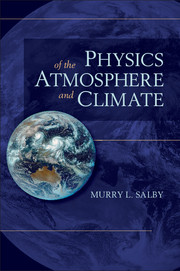Book contents
- Frontmatter
- Contents
- Preface
- Prelude
- 1 The Earth-atmosphere system
- 2 Thermodynamics of gases
- 3 The Second Law and its implications
- 4 Heterogeneous systems
- 5 Transformations of moist air
- 6 Hydrostatic equilibrium
- 7 Static stability
- 8 Radiative transfer
- 9 Aerosol and cloud
- 10 Atmospheric motion
- 11 Atmospheric equations of motion
- 12 Large-scale motion
- 13 The planetary boundary layer
- 14 Wave propagation
- 15 The general circulation
- 16 Dynamic stability
- 17 Influence of the ocean
- 18 Interaction with the stratosphere
- Appendix A Conversion to SI units
- Appendix B Thermodynamic properties of air and water
- Appendix C Physical constants
- Appendix D Vector identities
- Appendix E Curvilinear coordinates
- Appendix F Pseudo-adiabatic chart
- Appendix G Acronyms
- Answers to selected problems
- References
- Index
- Plate section
9 - Aerosol and cloud
Published online by Cambridge University Press: 05 June 2012
- Frontmatter
- Contents
- Preface
- Prelude
- 1 The Earth-atmosphere system
- 2 Thermodynamics of gases
- 3 The Second Law and its implications
- 4 Heterogeneous systems
- 5 Transformations of moist air
- 6 Hydrostatic equilibrium
- 7 Static stability
- 8 Radiative transfer
- 9 Aerosol and cloud
- 10 Atmospheric motion
- 11 Atmospheric equations of motion
- 12 Large-scale motion
- 13 The planetary boundary layer
- 14 Wave propagation
- 15 The general circulation
- 16 Dynamic stability
- 17 Influence of the ocean
- 18 Interaction with the stratosphere
- Appendix A Conversion to SI units
- Appendix B Thermodynamic properties of air and water
- Appendix C Physical constants
- Appendix D Vector identities
- Appendix E Curvilinear coordinates
- Appendix F Pseudo-adiabatic chart
- Appendix G Acronyms
- Answers to selected problems
- References
- Index
- Plate section
Summary
Radiative transfer is modified importantly by cloud. Owing to its high reflectivity in the visible, cloud shields the Earth-atmosphere system from solar radiation. It therefore introduces cooling in the SW energy budget of the Earth's surface, offsetting the greenhouse effect. Conversely, the strong absorptivity in the IR of water and ice sharply increases the optical depth of the atmosphere. Cloud thus introduces warming in the LW energy budget of the Earth's surface, reinforcing the greenhouse effect.
We develop cloud processes from a morphological description of atmospheric aerosol, without which cloud would not form. The microphysics controlling cloud formation is then examined. Macrophysical properties of cloud are developed in terms of environmental conditions that control the formation of particular cloud types. These fundamental considerations culminate in descriptions of radiative and chemical processes that involve cloud.
MORPHOLOGY OF ATMOSPHERIC AEROSOL
Small particulates suspended in air are produced and removed through a variety of processes. Those processes make the composition, size, and distribution of atmospheric aerosol widely variable (Table 9.1). Aerosol concentrations are smallest over ocean (Fig. 1.26), where a particle number density of n = 103 cm-3 is representative. They are greatest over industrialized continental areas, where n > 105 cm-3 is observed. These and other distinctions lead to two broad classes of tropospheric aerosol: continental and marine.
- Type
- Chapter
- Information
- Physics of the Atmosphere and Climate , pp. 266 - 327Publisher: Cambridge University PressPrint publication year: 2012



